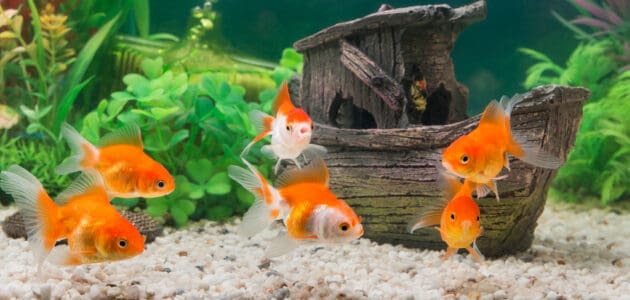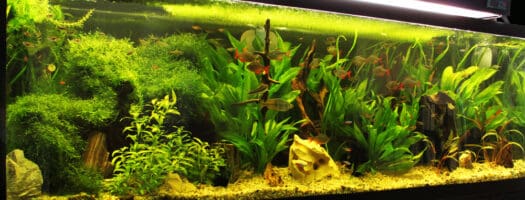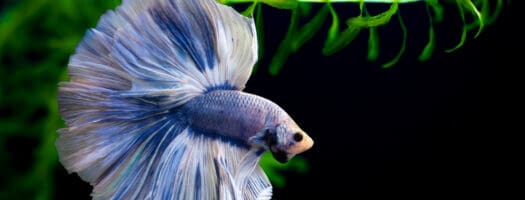What Fish Can Live With Goldfish?

Goldfish are one of the most popular species of aquarium fish and for good reason. They have friendly, peaceful natures, and their bright, golden color makes them wonderful to look at. Goldfish are also easy to care for and they can live long, happy lives if the conditions are right.
However, creating a community of species around your goldfish can be a trickier affair. There are several factors to consider, so it’s important to be informed before you start hunting for potential tank mates. The guide below will outline what you need to consider and what types of fish make ideal pals for your goldfish.
What Fish Can Goldfish Cohabit With?
Finding an aquarium mate for your goldfish can be a challenge, especially if you’re not sure what to look for. However, getting to know your goldfish’s personality and temperament can go a long way. Below are the key factors to consider when finding live-in tank mates for your goldfish.
Fun fact: Did you know that goldfish can grow up to 18 inches, which is larger than the size of a dinner plate? While most don’t reach this scale due to the size of their aquarium, it’s worth noting that many people underestimate how much space these fish can require. Therefore, it’s best not to squeeze them into a tiny space.
Water Temperature
One of the most important considerations when finding suitable goldfish mates is the temperature of the water. Goldfish thrive when the water is 65°F to 80°F, which means that the fish you add to the tank must be able to live within that range, too. Tropical fish, for example, prefer temperatures of 75°F to 80°F, so if the water is too cold, it might put undue stress on their system.
Instead, opt for fish that live within the cooler range so that they, and your goldfish, can happily co-exist.
Aggression
Another big consideration is the temperament of the fish. Goldfish are peaceful creatures and will not do well with other aggressive fish. Tiger Barbs or other tetra species, for example, will nip at your goldfish’s fins! Goldfish are not natural fighters and do not have the means to defend themselves either, so choose species that are known to be peaceful and non-aggressive. The last thing you want to do is cause grief for your goldfish.
Speed
Goldfish are notorious eaters. They will eat anything in sight if it’s small enough! Therefore, when choosing other species to cohabit with your goldfish, you’ll need to determine whether they are fast swimmers. Fast-moving fish will be able to avert your goldfish should they prey on them as a potential snack.
Size Matters
Size matters greatly when choosing a possible tank buddy. If the fish you choose will fit into a goldfish’s mouth, it’s best to stay away from them. However, if the fish is fast and able to avoid the clutches of your goldfish, it might be ok. In general, you can get away with fish that are a minimum length of 1.5 to 3 inches long.
Pro tip: On the subject of size, you should ensure you have a tank that has a capacity of at least 40 or 50 gallons. Many of the fish that can cohabit with goldfish are social and need to be kept in small schools, so be sure to have the correct tank size right off the bat.
Best Tank Mates for Your Goldfish
Despite the specific conditions that need to be met to house goldfish with other fish, there are quite a few species that will bode well. Below is our list of the top 8 fish that can make ideal tank companions for a goldfish. This is not an exhaustive list, but these are some of the prime candidates to be tankfellows for your goldfish.
1. Rosy Barbs
- Temperature: 64 – 72 °F
- Maximum Size: 6 inches
- Temperament: Peaceful
- Minimum Tank Size: 30 gallons
- Pros: These fish are peaceful and active.
- Cons: Due to their size and social disposition, a large tank is required.
Rosy Barbs make an excellent pal for your goldfish. Not only do they prefer the same type of water, but at 4 to 6 inches, they are also too big for a goldfish to gobble up! Rosy Barbs are also a non-aggressive fish, which makes them an ideal companion. Bear in mind that due to their length, you’ll need a large tank to house this species alongside your goldfish.
Pro tip: These fish prefer the company of their own kind and they get stressed if they are alone or in small groups. If you opt for Rosy Barbs, make sure they have at least 6 of their own kind to live with.
2. Giant Danio
- Temperature: 72 – 75 °F
- Maximum Size: 4 inches
- Temperament: Peaceful
- Minimum Tank Size: 30 gallons
- Pros: These fast, active fish, are big enough to avoid being eaten.
- Cons: A large tank is required to cater to their social need for at least 5 of its own kind.
Giant Danio’s can make a fine addition to a goldfish tank, particularly because of their size and temperament. These fast-moving fish are also pretty to look at due to their iridescent stripes. Like other fish on this list, Giant Danios are also social creatures, so they need to be kept in groups of at least 5.
Pro tip: Giant Danios’ quick speed means they can outswim a goldfish, so you’ll have to watch that they don’t out-compete for food.
3. Bristlenose Pleco
- Temperature: 70 – 80 °F
- Maximum Size: 5 inches
- Temperament: Peaceful
- Minimum Tank Size: 20 gallons
- Pros: These gentle fish are interesting to look at and will keep your tank clean.
- Cons: There is a small chance your Bristlenose will nip at your goldfish’s scales.
Bristlenose Pleco is a species of bottom-feeders that make great buddies for your goldfish. Not only are they too big to be eaten, but they are also known to be gentle. Bristlenose Plecos also feed off the algae in your tank, which helps keep it clean. It’s worth noting that Bristletoes don’t tend to nip at goldfish scales like other Pleco species. However, there is a small chance that this behavior might still come out.
Pro tip: While Bristlenose Plecos can make the bottom of a tank more interesting, their larger size means they’ll require a bigger tank, especially if you’ve got other fish inhabitants.
4. Platy
- Temperature: 64 – 77 °F
- Maximum Size: 3 inches
- Temperament: peaceful
- Minimum Tank Size: 10 gallons
- Pros: These fish are peaceful and easy to care for.
- Cons: They breed quite easily, so the babies are at risk of being eaten.
Platies are a type of freshwater fish that come in an abundance of colors. They have flattened bodies, a fan-like tail, and short fins. These little guys also breed quite easily, which means that the babies might get eaten by your wandering goldfish. This can have an advantage in terms of population control, though, particularly if your tank is small.
So, while Platies make great tank mates due to their disposition, there is some ‘food for thought’ here. If you don’t want your goldfish eating any of its cohabitants (babies included), you might want to opt for larger fish like the Rosy Barb or the Bristlenose Pleco.
Pro tip: Platies’ smaller size can also make them vulnerable to becoming a snack if your goldfish is of the larger variety. When considering these fish, assess the size of your goldfish first.
5. White Cloud Mountain Minnows
- Temperature: 45°-75°F
- Maximum Size: 2 inches
- Temperament: Peaceful
- Minimum Tank Size: 10 gallons
- Pros: These fish are hardy, quick swimmers.
- Cons: Their small size can put them at risk of being eaten by your goldfish.
White cloud minnows are a species of coldwater fish with lovely colorful markings. While these little guys are small enough to be gobbled up by a wandering goldfish, they are also quick enough swimmers to avert danger. These fish are also inexpensive and will only grow to a length of 1.5 to 2 inches long.
Pro tip: There are several types of white cloud minnows. Be sure to avoid the longfin variety because their long tails will slow them down, putting them at risk of being consumed for a goldfish’s dinner!
6. Dojo Loach (Weather Loach)
- Temperature: 45 – 77 °F
- Maximum Size: 11 inches
- Temperament: Peaceful
- Minimum Tank Size: 75 gallons
- Pros: These fish are friendly and non-aggressive.
- Cons: Their notoriously big size means they will require a very large tank.
Dojo Loaches are a popular freshwater fish due to their lovely and unique appearance. Their long eel-shaped body allows them to swim in a snakelike fashion, which makes them a joy to watch. These fish are friendly, easy to care for, and they have a novel ability to stay alive for hours when out of the water! They make excellent tank mates for goldfish because of their size and disposition.
Pro tip: Dojo Loaches also need to be with their kin, so you should house at least 3 of them to keep them happy. This requires a large tank so it’s something to be aware of.
7. Corydoras Catfish
- Temperature: 60 – 75 °F
- Maximum Size: 2.5 inches
- Temperament: Peaceful
- Minimum Tank Size: 30 gallons
- Pros: These fish are peaceful and will clean your aquarium.
- Cons: Because they dwell at the bottom of the tank, you might struggle to feed them properly.
Corydoras Catfish are another popular fish for aquarium lovers. Again, these fish can cohabit quite easily with your goldfish as they are peaceful in nature. These bottom dwellers scavenge off the scraps that fall to the aquarium floor, which helps keep your tank clean. However, there is a risk that any food you provide at the top will be gobbled up by your other fish.
Pro tip: Corydoras are a social bunch so you’ll need to keep these in schools of at least 5. Therefore, tank size is another consideration to make when deciding what fish to group together.
8. Apple Snails
- Temperature: 64 – 82 °F
- Maximum Size: 6 inches
- Temperament: Peaceful
- Minimum Tank Size: 5 gallons
- Pros: These snails add variety, and their shells prevent them from becoming goldfish food.
- Cons: They tend to eat live plants, so you’ll need to keep fakes ones in the tank.
Snails can make a fun addition to your fish tank. Not only are they unique to look at, but they also clean the algae off the aquarium walls. Snails are also great pals for your goldfish because they are peaceful creatures, and their hard shell prevents them from being eaten. If your goldfish is curious when the snail first arrives, it will likely leave it alone once it realizes the shell isn’t edible!
Pro tip: Apple snails can be less active in cooler goldfish waters so you might want to adjust the temperature slightly (but without compromising the other fish’s needs).
Which Tankmates Are Best for Your Goldfish?
To make a truly informed decision about which fish make the best mates for your goldfish, you’ll need to first assess the size of your tank. If you haven’t bought one yet, it’s a good idea to go a bit larger. Tank size is important not only for housing different species of fish, but you also want to give space for your goldfish to grow and to allow smaller fish an opportunity to swim away should they be chased.
It’s also worth reviewing the points above when it comes to the personality and temperament of other fish. By considering the peaceful nature of your goldfish, you can then assess other species in terms of their aggression levels. In general, it’s best to avoid most tetra species like neon tetra and dwarf gourami, as they tend to be more aggressive. Betta fish should also be avoided as they are known to be fin nippers!
In the end, you may need to have a bit of trial and error, too. If you notice that smaller fish are suddenly disappearing or that there are some fin nippers about, you may need to remove some species. But being informed about water temperature, fish speed, size, and temperament will go a long way towards helping you find the best tank buddies for your goldfish. If you’re looking for more information as you raise your goldfish, we have an article about the best goldfish foods so they can feast on the finest.




